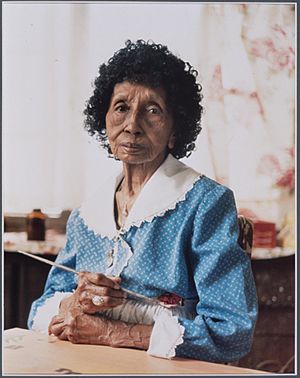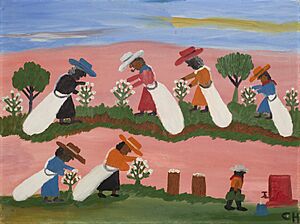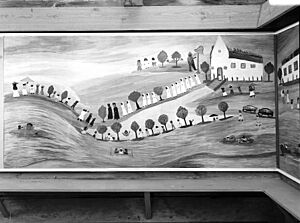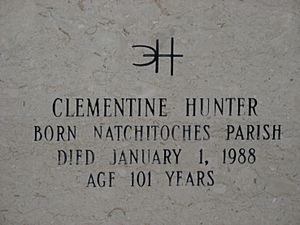Clementine Hunter facts for kids
Quick facts for kids
Clementine Hunter
|
|
|---|---|

Photograph by Judith Sedwick as part of the Black Women Oral History Project
|
|
| Born | December 1886 or January 1887 |
| Died | January 1, 1988 (aged 100) Natchitoches Parish, Louisiana
|
| Nationality | American |
| Occupation | Artist |
| Years active | 1940–1980 |
| Known for | Paintings of Black Southern life |
Clementine Hunter (pronounced Clementeen) (born late December 1886 or early January 1887 – died January 1, 1988) was a talented self-taught Black folk artist. She lived and worked on Melrose Plantation in the Cane River area of Louisiana.
Clementine was born into a Louisiana Creole family. She grew up on Hidden Hill Plantation near Cloutierville. From a young age, she worked on farms and never learned to read or write.
When she was in her fifties, Clementine started selling her paintings. Her artwork quickly became famous locally and across the country. People loved how she showed everyday Black Southern life in the early 1900s.
At first, she sold her paintings for as little as 25 cents. But by the end of her life, her art was shown in museums and sold for thousands of dollars. Clementine Hunter created an amazing number of paintings, possibly between 5,000 and 10,000!
In 1986, Northwestern State University gave her an honorary Doctor of Fine Arts degree. She was also the first African-American artist to have her own art show at the New Orleans Museum of Art. In 2013, a new opera about her life, called Zinnias: the Life of Clementine Hunter, was created by director Robert Wilson.
Contents
Early Life and Work
Clementine Hunter was born in late 1886 or early 1887. She was born on Hidden Hill Plantation in Natchitoches Parish, Louisiana. She was the first of seven children. Her family called her Tébé, which means "little baby" in French.
When she was about five, Clementine moved to Cloutierville. She went to St. John the Baptist Catholic Church School. The school was segregated, meaning Black and white students were kept separate. Clementine left school after less than a year. She never formally learned to read or write.
At eight years old, Clementine started working in the fields. She picked cotton alongside her father. Her family moved often in the Cane River Valley as her father looked for work. Around age fifteen, in 1902, she moved to Melrose Plantation.
On Melrose Plantation, Clementine worked as a farm laborer. She harvested cotton and pecans. She worked six days a week for many months of the year. In her teens, she took informal night classes with other workers at Melrose.
Around 1907, Clementine had her first child, Joseph Dupree. Her first partner was Charles Dupree. They had another child, Cora, a few years later. Charles Dupree passed away in 1914.
In 1924, Clementine married Emmanuel Hunter. He was a woodchopper at Melrose. Before marrying Emmanuel, Clementine only spoke Creole French. He taught her American English. They lived in a worker's cabin and had five children, though two were stillborn.
In the late 1920s, Clementine started working as a cook and housekeeper. She worked for Cammie Henry, the owner's wife at Melrose. Clementine was known for her cooking, sewing, and gardening skills. Melrose Plantation became a place where artists and writers visited. In the late 1930s, Clementine began to paint. She used leftover paints from the artists who visited Melrose.
In the early 1940s, Clementine's husband Emmanuel became very ill. She worked full-time to support her family. She also cared for Emmanuel and painted late at night. Emmanuel died in 1944.
Becoming an Artist

Clementine Hunter is one of the most famous self-taught artists. She is called a "memory painter" because she painted scenes from her life. She showed what Black Southern life was like in the Cane River Valley. She had no formal art training.
Her most famous paintings show important events. These include funerals, baptisms, and weddings. She also painted scenes of farm work, like picking cotton or pecans. She painted domestic work too. Hunter's paintings are known for their bright colors.
Hunter painted from her memories. She said, "I just get it in my mind and I just go ahead and paint." She didn't look at things while she painted. She made her own trees and scenes in her mind.
Cammie Henry created a place for artists at Melrose Plantation. Many artists and writers visited. It is often said that Clementine used paints left by an artist named Alberta Kinsey. However, Clementine herself said she started painting even earlier.

After her husband Emmanuel died, Hunter began selling her paintings. She put a sign outside her cabin that said: "Clementine Hunter, Artist. 25 cents to Look." Her first art shows were in Texas in 1945. In 1949, a show in New Orleans brought her more attention.
In 1953, an article about her was published in Look magazine. This made her famous across the country. François Mignon, a friend of Cammie Henry, helped Clementine a lot. He gave her paint and promoted her art. Her paintings were sold in the local drugstore for one dollar.
In 1956, Hunter and François Mignon wrote a cookbook together. It was called Melrose Plantation Cookbook. It had photos of Melrose and drawings by Clementine. It also included her traditional Creole recipes.

Hunter's biggest artworks are murals in the African House at Melrose Plantation. This house was built in the early 1800s by enslaved people. In 1955, Clementine and François Mignon worked together on these murals. They show the history of the Cane River Valley and scenes from her life. The murals have nine large panels. Hunter painted them in her home studio over three months. She was sixty-eight years old when she finished them.
Hunter's painting style changed over time. Her early works used more earthy and muted colors. She used paints left by other artists, so she worked with what was available. Later, arthritis in her hands affected her painting. She started painting more abstract and impressionist works. In the 1980s, when she was nearly 100, she painted on smaller items like jugs.
Quiltmaking and Other Art
Before she started painting, Clementine Hunter was skilled at sewing. She made clothes for her family and created quilts and baskets. François Mignon noticed her talent with fabric before he saw her paintings. In 1939, he wrote in his journal that Clementine made dolls with embroidered faces. She was also very good at making fringe and spinning cotton.
Hunter's quilts and tapestries show her artistic talent before she painted. They often feature subjects and colors similar to her paintings. Many of her quilts are called "Melrose Quilt" because they show buildings from the plantation. Most of her fabric art is in private collections.
Hunter also made abstract quilts. One of her Chevron Quilts is at the New Orleans Museum of Art. These quilts have alternating solid colors and patterned fabric squares. This shows her interest in abstract art even before her later abstract paintings.
Legacy and Honors
A director from the American Folk Art Museum called Clementine Hunter "the most celebrated of all Southern contemporary painters."
Hunter was the first African-American artist to have a solo exhibition at the Delgado Museum. This museum is now the New Orleans Museum of Art. In 1985, the museum held a special exhibit for her 100th birthday. She received many honors during her life. She was invited to the White House by U.S. President Jimmy Carter. She also received letters from President Ronald Reagan and U.S. Senator J. Bennett Johnston, Jr..
Radcliffe College included Hunter in its Black Women Oral History Project in 1980. Her interviews are kept at Harvard University. Northwestern State University also has digitized interviews with Hunter and people close to her.
In 1986, Northwestern State University gave her an honorary Doctor of Fine Arts degree. The next year, Louisiana Governor Edwin Edwards made her an honorary colonel.
Many books have been written about Clementine Hunter's life and art. In 2013, an opera was created about her. A musical also honors her life.
Hunter's artwork is displayed in many museums. These include the Dallas Museum of Fine Art, the American Folk Art Museum, and the New Orleans Museum of Art.
In 2017, a documentary called Clementine Hunter's World was released. It celebrates her life and art. The Smithsonian National Museum of African American History & Culture also created an exhibition about her. It is called "Clementine Hunter: Life on Melrose Plantation." This museum has the largest collection of her work by a single artist.
In 2019, Louisiana State Legislators made October 1 "Clementine Hunter Day." This day honors her important legacy in Louisiana.
Protecting Her Art
As Clementine Hunter became more famous, her paintings became more valuable. This led to a problem with fake paintings. Some people tried to sell art that looked like hers but wasn't.
One person, William Toye, was accused of making many fake Hunter paintings. He copied her special signature, which was a backwards C and an H linked together. Experts later found that the materials used in the fake paintings were different from Hunter's originals.
An important clue to finding real Hunter paintings was her fingerprints. Clementine Hunter didn't use an easel. She often got paint smudges on the back and edges of her oil paintings. The fake paintings made by Toye did not have these smudges because he used an easel.
In 2009, the Federal Bureau of Investigation (FBI) started a formal investigation into the fake paintings. Experts analyzed the paint, age, and style of the artworks. This investigation helped protect Clementine Hunter's artistic legacy. It also showed how important self-taught artists are in the art world.
Images for kids
-
Black Jesus (c.1985) at the National Gallery of Art in Washington, DC in 2022
See also
 In Spanish: Clementine Hunter para niños
In Spanish: Clementine Hunter para niños
- Mose Tolliver
- Outsider art
- Folk Art
- Southern art
- Melrose Plantation




